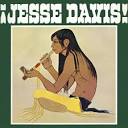Photo: Jesse Ed Davis album cover | By Jim Farber, The Guardian / Yahoo | Three-quarters of the way through John Lennon’s stirring take on Stand By Me, a guitar sneaks into the mix with a solo so supple and sweet, it feels like a kiss. In Bob Dylan’s Watching the River Flow, it’s a wily slide guitar that seizes center stage with a sound both witty and free, while halfway through Jackson Browne’s Doctor My Eyes, a guitar solo winds up changing the entire trajectory of the song, making it soar from a chugging ballad to a flat-out rocker.
In each case, the guitarist responsible for adding those shapes and colors to the music is Jesse Ed Davis. Though little remembered today, Davis was the go-to session guitarist for music’s greatest stars of the late 60s through the 70s. His tasteful licks and surgical leads turned up on solo albums by three out of the four Beatles (all but Paul), and alighted on recordings by Rod Stewart (including the No 1 hit Tonight’s the Night), Eric Clapton, Leon Russell, Bryan Ferry, Willie Nelson, Harry Nilsson, Gram Parsons and scores more.
Onscreen, Davis can be seen playing lead in Taj Mahal’s seminal band when they performed on the Rolling Stones’ 1968 all-star special Rock and Roll Circus. Three years later, he was part of the core band at the epic Concert for Bangladesh event organized by George Harrison. Then, in 1975, he was asked to play second guitar on Rod Stewart and the Faces’ final tour. In between, Davis somehow found time to record three albums of his own, on which stars like Clapton, Russell and Dr John backed him. Yet, despite all that exposure and respect, there’s a tragic side to Davis’s story. His career and talent were ravaged by a drug habit that led to his death from a heroin overdose in 1988 at the age of 43.
Now, 35 years later, there’s a movement afoot both to remind classic rock fans of Davis’s work and to introduce it to a new generation. This week, the legacy label Real Gone Music will rerelease Davis’s self-titled debut solo album from 1970. An acclaimed documentary, titled Rumble, that features the guitarist can also be seen on Netflix. Rumble chronicles the impact Native Americans like Davis have had on popular music. (The guitarist had Comanche, Seminole, Muskogee and Cheyenne heritage on his father’s side, and Kiowa on his mother’s.) Davis will also be celebrated by a forthcoming book written about him by Douglas K Miller, a scholar of Native American culture who wrote Indians on the Move: Native American Mobility and Urbanization in the Twentieth Century.
“Here’s a guy who played on over 100 of the greatest albums of the classic rock era, who inspired more people than we can count, yet he’s not known by most people,” Miller said. “But even if you don’t know who he is, you’ve heard him.”
> > > > > > > > >
“To me, what stood out was his tone and his feel,” Trucks said. “There was something so cool in the way he played. He was never in a rush. And there was something piercing and clear about his playing.”
“He was going for a cleaner blues sound,” Salas said. “He didn’t use a lot of distortion. If you’re a guitar player, that’s the hardest sound to play because it’s the most unforgiving.”
> > > > > > > > >
However, on 28 June 1988 Jesse Ed Davis died with fresh needle marks in his arm. While Miller acknowledges that “Jesse’s death was a tragedy”, he emphasizes that “his life was not”.
That’s especially true given the deep shelf of great work he left. For those who appreciate it, the goal now is to make sure more people know about it. “People often call Billy Preston ‘the fifth Beatle’,” Salas said. “But Jesse played with nearly all of the Beatles, yet he’s invisible. We’re trying to make him visible.”
Jesse Davis will be rereleased on 9 September
> > > > > > > >
Go here to read more:
https://www.yahoo.com/entertainment/8-old-taken-off-life-000139347.html
http://realgonemusic.com

Home
ResearchHe Played With Dylan, Clapton and Lennon: The Unsung Genius of Guitarist Jesse Ed Davis
